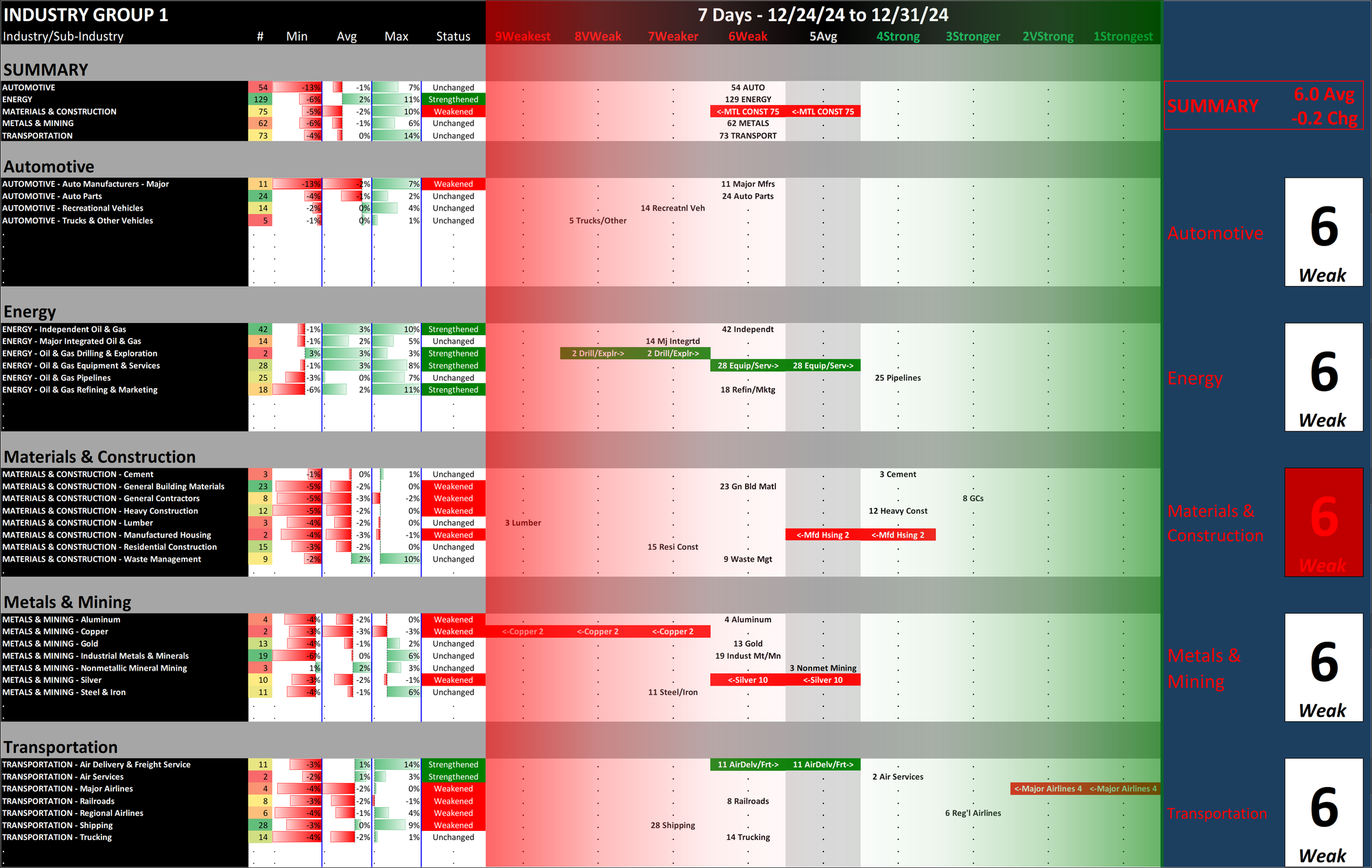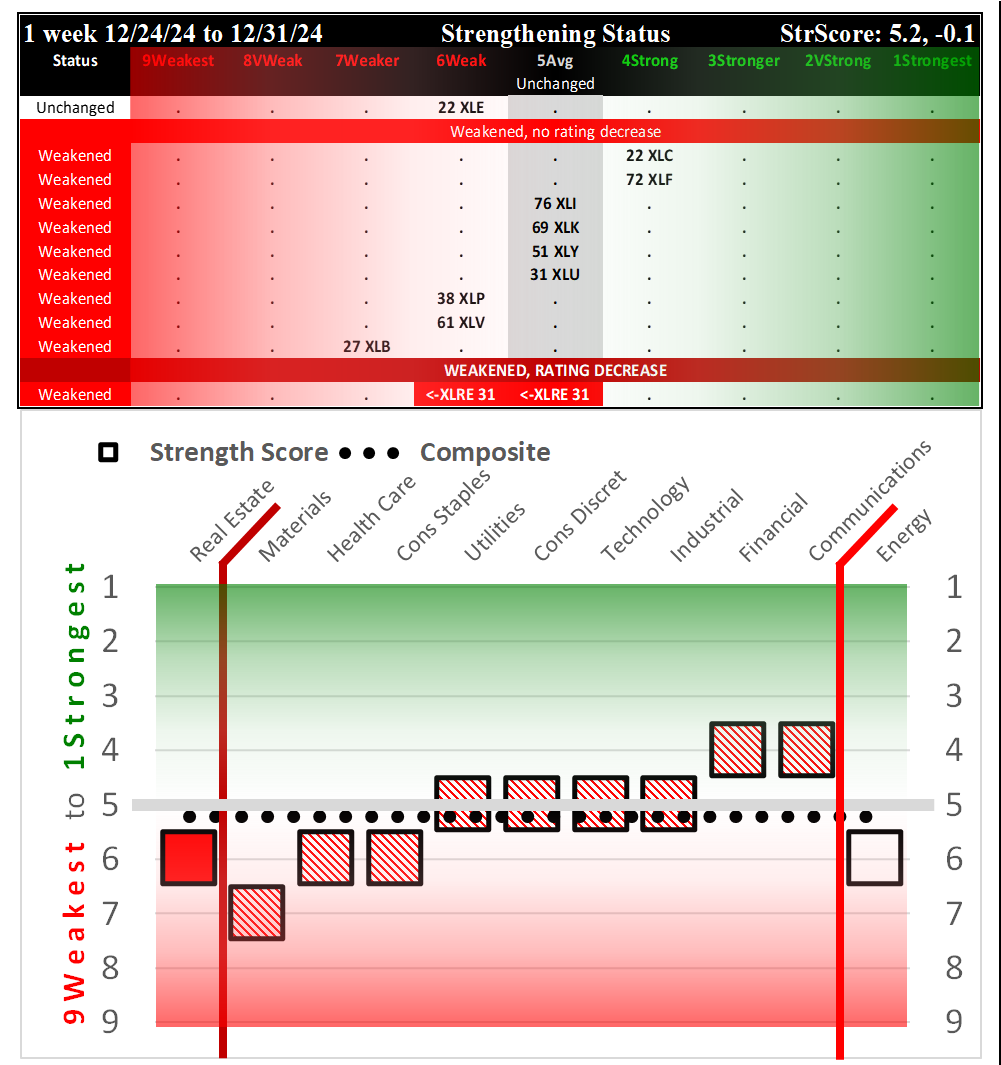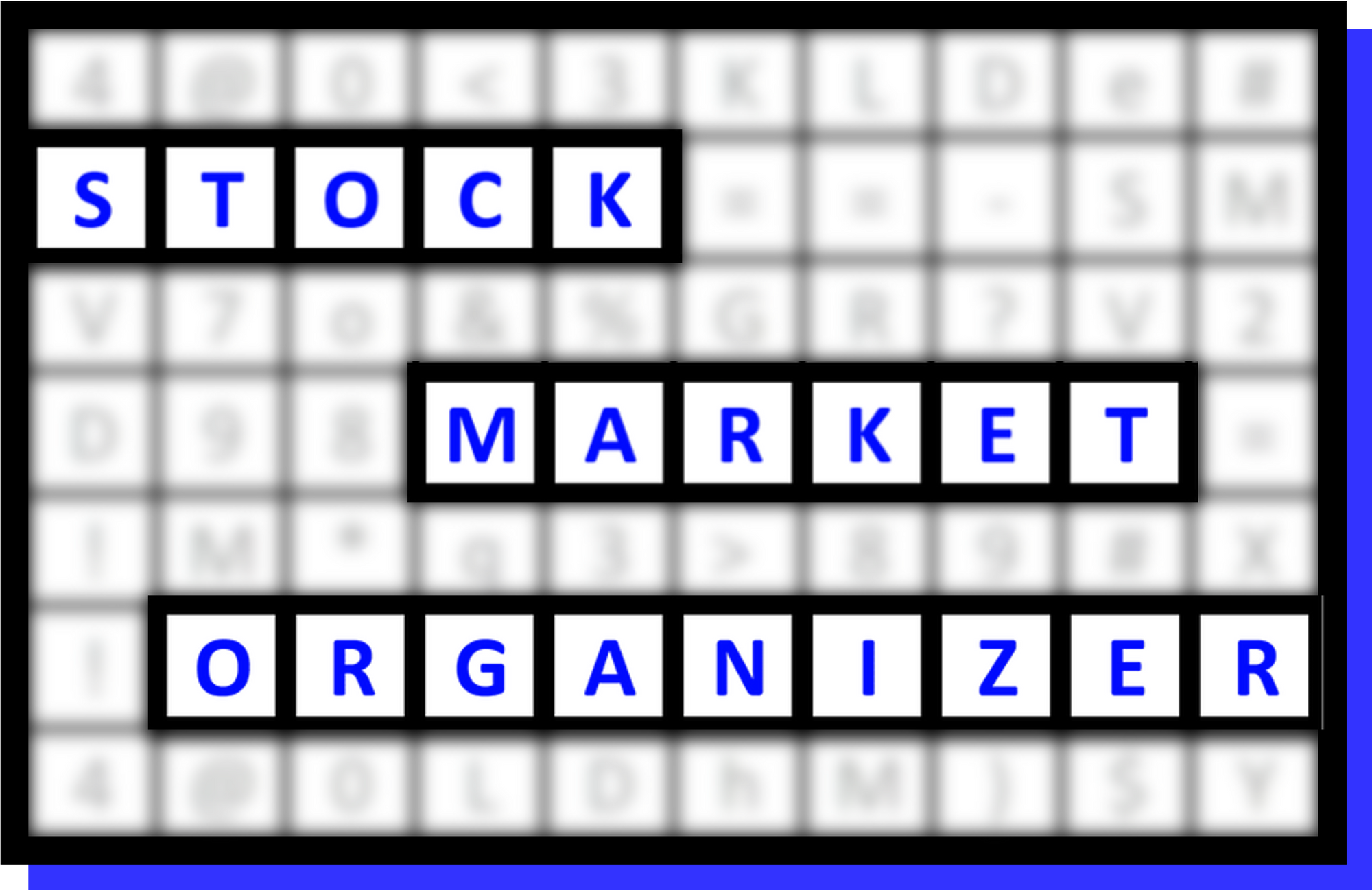SMO Exclusive: Strength Report Industry Group 1 2024-12-31 Weakened -0.2 to 6.0 Strength Score

Overview
This post consists of the following sections:
I. KEY BACKGROUND INFORMATION
II. TECHNOLOGY SECTOR DETAILED ANALYSIS
SECTION I: KEY BACKGROUND INFORMATION
Sector Weekly Summary
Industry Group 1 weakened by 0.2 points to a 6.0 composite score (6Weak) this week as one of five industries fell one strength rating level.
All industries are at 6Weak, with four unchanged at that level for the week (Automotive, Energy, Metals & Mining, and Transportation) while Materials & Construction fell one strength level.
Difference This vs. ETFs Analysis
Note this analysis is the same as that used for the SPDR ETFs published every Tuesday and Friday (here is today's report dated December 31, 2024) but the two main differences are:
1. Universe of stocks. The ETFs are the largest capitalization stocks, 500 of them in the 11 sector ETFs. In this analysis, there are approximately 2,700 stocks.
2. Sub-categorization below the market level. The ETF analysis with 500 stocks is limited to sector strengthening and weakening. This analysis with +/-2,700 stocks can be and is segregated into 29 industry groups and in turn 189 sub-industry groups.
Of the five industries in this grouping, there is only one matching ETF which is the Energy ETF (symbol XLE). This ETF has a 6Weak rating, just like the Energy industry in this analysis, reflecting that the 22 large cap stocks that comprise the ETF have a matching strength rating to the 130 Energy industry stocks.

December 31, 2024 strength ratings for the 11 SPDR ETFs show the XLE/Energy ETF at 6Weak, the best performing (relatively speaking) ETF at unchanged. All other ETFs weakened.
How would I interpret and use this information?
Recognizing that anything can happen at any time and I will never know the reason why until after the fact if ever, I am looking to give myself the best chances of an individual stock going my desired direction by stacking strength going long or stacking weakness going short, depending on strength/strengthening and weakness/weakening at the stock, sub-industry, industry, sector, and market levels. One quick way to discern this is to look at the differing market levels in terms of headwinds and tailwinds as noted below.
Current Market Environment: TAILWIND
- MARKET: The Market Strength Score changed to negative ("risk on") as of Friday, December 27 = TAILWIND
Current Industry/Sub-Industry Environment
This industry grouping is not homogenous as are Technology and Financial. Therefore, there is no relevant "Sector" headwind and tailwind for these industry groups. The individual industry head/tailwinds are noted below. If interested in positions in these industries, it is better to go where there is strength and strengthening - as reflected by price. This Stock Market Organizer methodology explicitly reveals where there is strength/strengthening.
- Automotive was unchanged at 6Weak = headwind
- Energy was unchanged at 6Weak = headwind
- Materials and Construction (including Homebuilders) weakened one strength rating to 6Weak = headwind
- Metals & Mining was unchanged at 6Weak = headwind
- Transportation was unchanged at 6Weak = headwind
There is absolutely no way of determining how long this environment will last. All one can do is find an objective way of measuring whether any given environment offers headwinds or tailwinds and then act accordingly based on these measurements.
Details are below shown in a manner not available elsewhere because I created it from scratch to continually answer this question: “Where is there strengthening and weakening in the market at the stock, sub-industry, industry, and sector levels?” Combine this with the top-down Market Strength Score and Sector Risk Gauge to get a key competitive advantage of understanding strength at every level. Why? Because the market does not have to be so complicated.
SECTION II: FINANCIAL SECTOR DETAILED ANALYSIS
Section Table of Contents
- Introduction - Industry Components
- INDUSTRY 1-Week Strengthening, Positive/Negative % Stocks
- INDUSTRY 10-Week Strengthening
- SUB-INDUSTRY 10-Week Strengthening
- STOCKS Outliers: Strongest/Weakest Rated
- STOCKS Outliers: 1-Week % Change
- STOCKS Outliers: 5-Year Highs/Lows
1. Introduction - Industry Components
Automotive
Largest of 4 sub-industries (54 stocks, average 14):
- Auto Parts (24 stocks)
- Auto Manufacturers - Major (14 stocks)
- Recreational Vehicles (11 stocks)
Top 10 Market Caps:
TSLA/Tesla Inc, TM/Toyota Motor Corporation ADS, RACE/Ferrari NV, GM/General Motors Company, PCAR/Paccar Inc, JCI/Johnson Controls Inc, HMC/Honda Motor Co. Ltd. ADS, F/Ford Motor Co, STLA/Stellantis N.V., LI/Li Auto Inc
Energy
Largest of 6 sub-industries (130 stocks, average 22):
- Independent Oil & Gas (43 stocks)
- Oil & Gas Equipment & Services (27 stocks)
- Oil & Gas Pipelines (25 stocks)
- Oil & Gas Refining & Marketing (18 stocks)
- Major Integrated Oil & Gas (14 stocks)
Top 10 Market Caps:
XOM/Exxon Mobil Corporation, CVX/Chevron Corp, TTE/TotalEnergies SE, COP/ConocoPhillips, PBR/Petroleo Brasileiro S.A., BP/BP P.L.C., ENB/Enbridge Inc., EQNR/Equinor ASA, CNQ/Canadian Natural Res Ltd, EOG/Eog Resources Inc
Materials & Construction
Largest of 8 sub-industries (75 stocks, average 10):
- General Building Materials (23 stocks)
- Residential Construction (15 stocks)
- Heavy Construction (12 stocks)
- Waste Management (10 stocks)
Top 10 Market Caps:
WM/Waste Management Inc, CARR/Carrier Global Corporation, RSG/Republic Services Inc, DHI/D.R. Horton Inc, LEN/Lennar Corp Cl A, PWR/Quanta Services Inc, WCN/Waste Connections Inc, FAST/Fastenal Company, MLM/Martin Marietta Materials Inc, VMC/Vulcan Materials Cop
Metals & Mining
Largest of 7 sub-industries (62 stocks, average 9):
- Industrial Metals & Minerals (19 stocks)
- Gold (13 stocks)
- Steel & Iron (11 stocks)
- Silver (10 stocks)
Top 10 Market Caps:
SCCO/Southern Copper Corp, FCX/Freeport-McMoran Inc, NEM/Newmont Corporation, AEM/Agnico Eagle Mines Ltd, NUE/Nucor Corp, GOLD/Barrick Gold Corp, WPM/Wheaton Precious Metals Corp, FNV/Franco Nevada Corp, TECK/Teck Resources Limited, CCJ/Cameco Corp
Transportation
Largest of 7 sub-industries (73 stocks, average 10):
- Shipping (28 stocks)
- Trucking (14 stocks)
- Air Delivery & Freight Service (11 stocks)
Top 10 Market Caps:
UNP/Union Pacific Corp, UPS/United Parcel Service Inc, CP/Canadian Pacific Railway Ltd, CNI/Canadian Natl Railway, FDX/Fedex Corp, CSX/CSX Corp, NSC/Norfolk Southern Corp, ODFL/Old Dominion Freight Lines Inc, DAL/Delta Air Lines Inc, WAB/Westinghouse Air Brake Technologies Corp
2. INDUSTRY 1-Week Strengthening
Overview
What: A closer 1-week look at industry and sub-industry strengthening
Why: a multi-month rally begins with one up week. Meaningful moves last and can last longer than expected.

Positive/Negative % Stocks

3. INDUSTRY 10-Week Strengthening
Overview
What: A comparative 10-week look at industry strengthening
Why: clearly and quickly understand where there is strengthening and weakening over a relevant time frame

4. SUB-INDUSTRY 10-Week Strengthening
Overview
What: recent week-by-week strength changes for the industry and its sub-industries
Why: objective measurement of strengthening and weakening enabling comparison within and across industries and sub-industries

Automotive

Energy

Materials & Construction

Metals & Mining

Transportation

5. STOCKS Outliers: Strongest/Weakest Rated
Overview
What: stocks currently rated Strongest/Weakest (highest/lowest of 9 strength ratings)
Why: these are interesting stocks for available capital because
- The Strongest have the least amount of overhead supply to dampen breakouts while
- the Weakest may be prone to volatility, subject to big pops from bottom-fishing and short-covering BUT ALSO to bigger and faster falls.
- (Not guaranteed and not a recommendation - weak stocks in weakening sub-industries may be better shorts than high-flyers.)

Automotive

Energy

Materials & Construction

Metals & Mining

Transportation

6. STOCKS Outliers: 1-Week % Change
Overview
What: stocks with atypically strong or weak performance this week
Why: these are interesting stocks for available capital because
- The journey to 100%+ returns begins with 10% returns...
- Strength can beget strength
- So too weakness
- Momentum and trend-following are time-tested. - A multi-month rally begins with one up week...
- Meaningful moves last
- And can last longer than expected.

Automotive

Energy

Materials & Construction

Metals & Mining

Transportation

7. STOCKS Outliers: 5-Year Highs/Lows
Overview
What: stocks at 5-year highs and lows
Why: potential large and/or rapid price movement
This section shows the strongest of the strong and the weakest of the weak, hitting 5-year highs and lows, respectively. The strongest are the leaders of the market that, until today, had been regularly hitting new highs. Meanwhile, there is no rational reason to hold weak stocks that are at multi-year lows. There are far too many other attractive choices to waste time or capital on such candidates.


